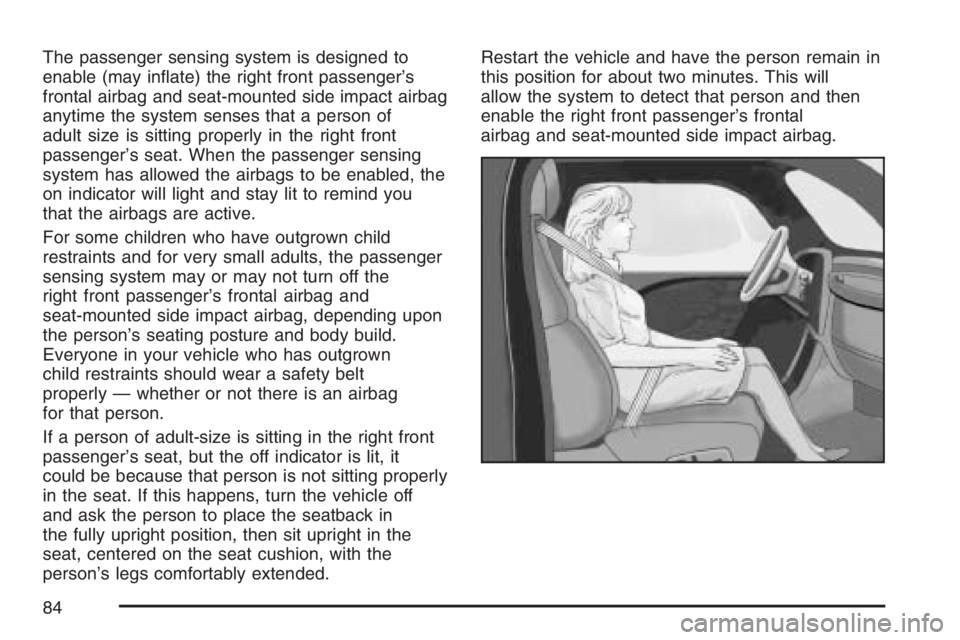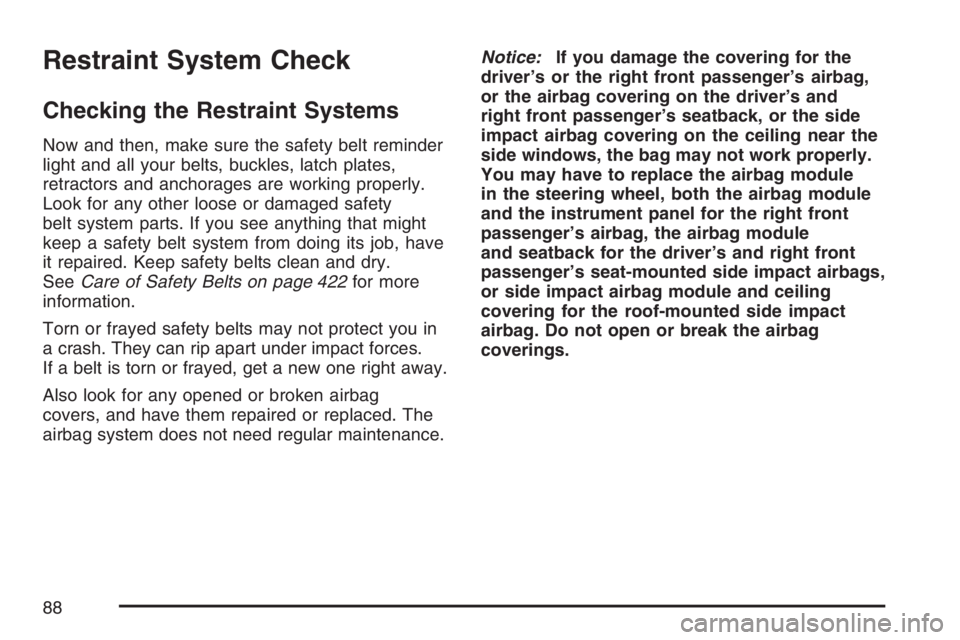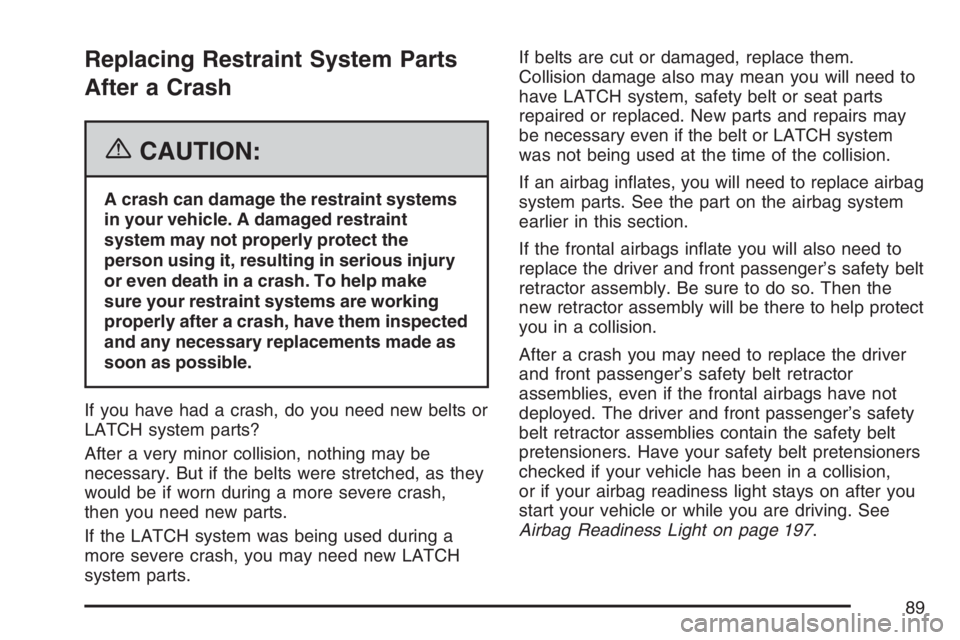2007 BUICK LUCERNE belt
[x] Cancel search: beltPage 77 of 496

If the front of your vehicle goes straight into a wall
that does not move or deform, the threshold
level for the reduced deployment is about
12 to 16 mph (19 to 26 km/h), and the threshold
level for a full deployment is about 17 to 22 mph
(27 to 35 km/h) if the other sensors do not
over-ride this. The threshold level can vary,
however, with speci�c vehicle design, so that it
can be somewhat above or below this range.
Frontal airbags may in�ate at different crash
speeds. For example:
If the vehicle hits a stationary object, the
airbags could in�ate at a different crash speed
than if the vehicle hits a moving object.
If the vehicle hits an object that deforms, the
airbags could in�ate at a different crash
speed than if the vehicle hits an object that
does not deform.
If the vehicle hits a narrow object (like a pole),
the airbags could in�ate at a different crash
speed than if the vehicle hits a wide object
(like a wall).
If the vehicle goes into an object at an angle,
the airbags could in�ate at a different crash
speed than if the vehicle goes straight into the
object.
Frontal airbags (driver and right front passenger)
are not intended to in�ate during vehicle
rollovers, rear impacts, or in many side impacts.
Your vehicle has sensors which enable the
sensing system to monitor the position of the right
front passenger’s seat, whether the occupant is
buckled or unbuckled. The passenger seat position
sensor and passenger safety belt buckle switch
provide information which is used to determine if
the airbags should deploy at a reduced level or full
deployment.
77
Page 79 of 496

How Does an Airbag Restrain?
In moderate to severe frontal or near frontal
collisions, even belted occupants can contact the
steering wheel or the instrument panel. In
moderate to severe side collisions, even belted
occupants can contact the inside of the vehicle.
Airbags supplement the protection provided
by safety belts. Airbags distribute the force of the
impact more evenly over the occupant’s upper
body, stopping the occupant more gradually. But
the frontal airbags would not help you in many
types of collisions, including rollovers, rear
impacts, and many side impacts, primarily because
an occupant’s motion is not toward the airbag.
Side impact airbags would not help you in many
types of collisions, including many frontal or
near frontal collisions, rollovers, and rear impacts.
Airbags should never be regarded as anything
more than a supplement to safety belts, and then
only in moderate to severe frontal or near-frontal
collisions for the driver’s and right front
passenger’s frontal airbags, and only in moderate
to severe side collisions for vehicles with side
impact airbags.
What Will You See After an Airbag
In�ates?
After frontal airbags and seat-mounted side impact
airbags in�ate, they quickly de�ate, so quickly
that some people may not even realize an airbag
in�ated. Roof-mounted side impact airbags
may still be at least partially in�ated minutes after
the vehicle comes to rest. Some components
of the airbag module — the steering wheel hub for
the driver’s airbag, the instrument panel for the
right front passenger’s bag, the side of the
seatback closest to the door for the seat-mounted
side impact airbags, and the area along the
ceiling of your vehicle near the side windows for
roof-mounted side impact airbags — may be
hot for a short time. The parts of the airbag that
come into contact with you may be warm, but not
too hot to touch.
79
Page 81 of 496

Let only quali�ed technicians work on the
airbag systems. Improper service can
mean that an airbag system will not work
properly. See your dealer for service.
Passenger Sensing System
Your vehicle has a passenger sensing system.
The passenger airbag status indicator on the
overhead console will be visible when you turn
your ignition key to RUN or START.
The words ON and OFF or the symbol for on and
off, will be visible during the system check.
When the system check is complete, either the
word ON or the word OFF, or the symbol for on or
the symbol for off will be visible. SeePassenger
Airbag Status Indicator on page 198.The passenger sensing system will turn off the
right front passenger’s frontal airbag and
seat-mounted side impact airbag under certain
conditions. The driver’s airbags are not part of the
passenger sensing system.
The passenger sensing system works with sensors
that are part of the right front passenger’s seat and
safety belt. The sensors are designed to detect the
presence of a properly-seated occupant and
determine if the right front passenger’s frontal
airbag and seat-mounted side impact airbag should
be enabled (may in�ate) or not.
Accident statistics show that children are safer if
they are restrained in the rear rather than the front
seat. We recommend that child restraints be
secured in a rear seat, including an infant riding in
a rear-facing infant seat, a child riding in a
forward-facing child seat and an older child riding
in a booster seat.
United StatesCanada
81
Page 84 of 496

The passenger sensing system is designed to
enable (may in�ate) the right front passenger’s
frontal airbag and seat-mounted side impact airbag
anytime the system senses that a person of
adult size is sitting properly in the right front
passenger’s seat. When the passenger sensing
system has allowed the airbags to be enabled, the
on indicator will light and stay lit to remind you
that the airbags are active.
For some children who have outgrown child
restraints and for very small adults, the passenger
sensing system may or may not turn off the
right front passenger’s frontal airbag and
seat-mounted side impact airbag, depending upon
the person’s seating posture and body build.
Everyone in your vehicle who has outgrown
child restraints should wear a safety belt
properly — whether or not there is an airbag
for that person.
If a person of adult-size is sitting in the right front
passenger’s seat, but the off indicator is lit, it
could be because that person is not sitting properly
in the seat. If this happens, turn the vehicle off
and ask the person to place the seatback in
the fully upright position, then sit upright in the
seat, centered on the seat cushion, with the
person’s legs comfortably extended.Restart the vehicle and have the person remain in
this position for about two minutes. This will
allow the system to detect that person and then
enable the right front passenger’s frontal
airbag and seat-mounted side impact airbag.
84
Page 87 of 496

Adding Equipment to Your
Airbag-Equipped Vehicle
Q:Is there anything I might add to the front
or sides of the vehicle that could keep the
airbags from working properly?
A:Yes. If you add things that change your
vehicle’s frame, bumper system, height,
front end or side sheet metal, they may keep
the airbag system from working properly.
Also, the airbag system may not work properly
if you relocate any of the airbag sensors. If
you have any questions about this, you should
contact Customer Assistance before you
modify your vehicle. The phone numbers and
addresses for Customer Assistance are in
Step Two of the Customer Satisfaction
Procedure in this manual. SeeCustomer
Satisfaction Procedure on page 460.
Q:Because I have a disability, I have to get
my vehicle modi�ed. How can I �nd out
whether this will affect my airbag system?
A:Changing or moving any parts of the
front seats, safety belts, the airbag sensing
and diagnostic module, steering wheel,
instrument panel, ceiling headliner, ceiling and
pillar garnish trim, roof-mounted airbag
modules, or airbag wiring can affect the
operation of the airbag system. If you have
questions, call Customer Assistance. The
phone numbers and addresses for Customer
Assistance are in Step Two of the Customer
Satisfaction Procedure in this manual.
SeeCustomer Satisfaction Procedure
on page 460.
87
Page 88 of 496

Restraint System Check
Checking the Restraint Systems
Now and then, make sure the safety belt reminder
light and all your belts, buckles, latch plates,
retractors and anchorages are working properly.
Look for any other loose or damaged safety
belt system parts. If you see anything that might
keep a safety belt system from doing its job, have
it repaired. Keep safety belts clean and dry.
SeeCare of Safety Belts on page 422for more
information.
Torn or frayed safety belts may not protect you in
a crash. They can rip apart under impact forces.
If a belt is torn or frayed, get a new one right away.
Also look for any opened or broken airbag
covers, and have them repaired or replaced. The
airbag system does not need regular maintenance.Notice:If you damage the covering for the
driver’s or the right front passenger’s airbag,
or the airbag covering on the driver’s and
right front passenger’s seatback, or the side
impact airbag covering on the ceiling near the
side windows, the bag may not work properly.
You may have to replace the airbag module
in the steering wheel, both the airbag module
and the instrument panel for the right front
passenger’s airbag, the airbag module
and seatback for the driver’s and right front
passenger’s seat-mounted side impact airbags,
or side impact airbag module and ceiling
covering for the roof-mounted side impact
airbag. Do not open or break the airbag
coverings.
88
Page 89 of 496

Replacing Restraint System Parts
After a Crash
{CAUTION:
A crash can damage the restraint systems
in your vehicle. A damaged restraint
system may not properly protect the
person using it, resulting in serious injury
or even death in a crash. To help make
sure your restraint systems are working
properly after a crash, have them inspected
and any necessary replacements made as
soon as possible.
If you have had a crash, do you need new belts or
LATCH system parts?
After a very minor collision, nothing may be
necessary. But if the belts were stretched, as they
would be if worn during a more severe crash,
then you need new parts.
If the LATCH system was being used during a
more severe crash, you may need new LATCH
system parts.If belts are cut or damaged, replace them.
Collision damage also may mean you will need to
have LATCH system, safety belt or seat parts
repaired or replaced. New parts and repairs may
be necessary even if the belt or LATCH system
was not being used at the time of the collision.
If an airbag in�ates, you will need to replace airbag
system parts. See the part on the airbag system
earlier in this section.
If the frontal airbags in�ate you will also need to
replace the driver and front passenger’s safety belt
retractor assembly. Be sure to do so. Then the
new retractor assembly will be there to help protect
you in a collision.
After a crash you may need to replace the driver
and front passenger’s safety belt retractor
assemblies, even if the frontal airbags have not
deployed. The driver and front passenger’s safety
belt retractor assemblies contain the safety belt
pretensioners. Have your safety belt pretensioners
checked if your vehicle has been in a collision,
or if your airbag readiness light stays on after you
start your vehicle or while you are driving. See
Airbag Readiness Light on page 197.
89
Page 102 of 496

Doors and Locks
Door Locks
{CAUTION:
Unlocked doors can be dangerous.
Passengers, especially children, can
easily open the doors and fall out of a
moving vehicle. When a door is
locked, the handle will not open it.
You increase the chance of being
thrown out of the vehicle in a crash if
the doors are not locked. So, wear
safety belts properly and lock the
doors whenever you drive.
CAUTION: (Continued)
CAUTION: (Continued)
Young children who get into unlocked
vehicles may be unable to get out. A
child can be overcome by extreme
heat and can suffer permanent injuries
or even death from heat stroke.
Always lock your vehicle whenever
you leave it.
Outsiders can easily enter through an
unlocked door when you slow down
or stop your vehicle. Locking your
doors can help prevent this from
happening.
There are several ways to lock and unlock your
vehicle.
From the outside, use either the key or the remote
keyless entry (RKE) transmitter.
102